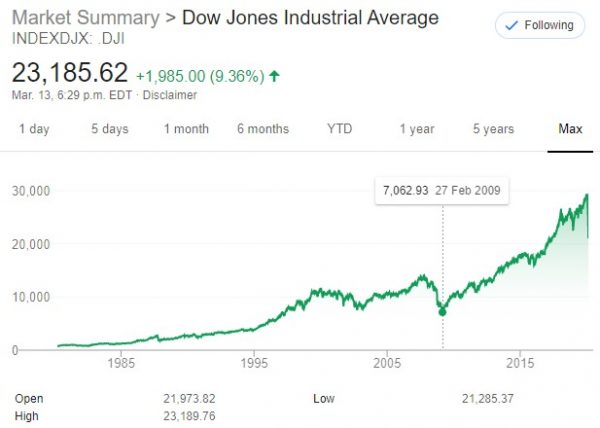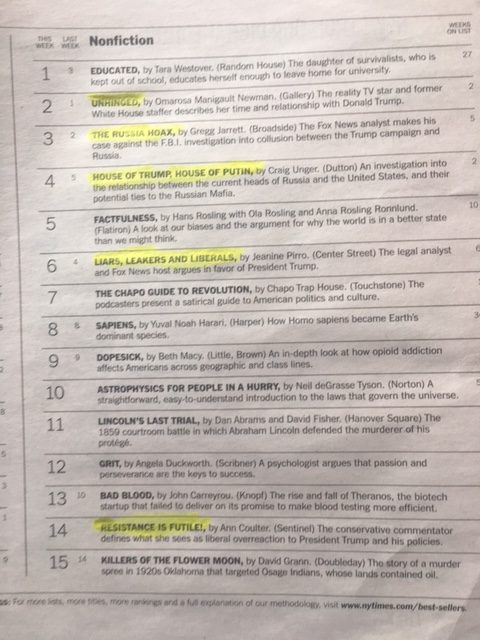Unless you’ve been living under a rock, the stock markets have been a terrible mess.
On our Canadian side, we triggered market circuit breakers to halt trading in recent days.
In the U.S., the stock market dropped thousands of points in rapid successive trading days and remains well into bear-market territory within just a matter of weeks. It’s as almost if the market jumped out of a plane with a faulty parachute and spiraled out of control to earth; only some mild turbulence kept it from a total free fall.

All havoc, no sanity
These market dives in very short order made me reflect on my own investing journey and how I might be able to survive this stock market crash. For today’s post, here are my ideas on how to get through a stock market crash – and benefit from it.
1.) Learn from history – reset your expectations
A sudden stock market crash is quite unnerving, but I don’t think it’s a sign of imminent full-on financial collapse. At least history tells us so. You’ll see from the chart above, recent weeks have been very messy to say the least. But over many years of investing in equities, the chart actually looks like this:

I’ve highlighted near the bottom of the 2008-2009 Great Recession for reference.
Although it’s very difficult to wrap your head around this fact and behave accordingly, stock market history consistently tells us the financial markets do eventually recover. And, after they recover, looking back through time, they continue to deliver rather predictable long-term returns. Here is what the U.S. stock market has returned by the decade and from what:

Source: https://awealthofcommonsense.com/2019/12/where-have-all-the-stock-market-returns-come-from-this-decade/
Even near-term, our Canadian and U.S. stock markets have been a very good place to be to build wealth:
| Index |
Proxy Fund |
5-year return |
10-year return |
Since inception |
| S&P/TSX (Canada) |
XIC |
6.27% |
6.77% |
6.53% (2001) |
| S&P 500 (U.S.) |
IVV |
11.65% |
13.50% |
6.15% (2000) |
Source: iShares site, up to December 2019.
I firmly believe this is why you need to stay invested throughout a stock market crash.
What goes down will (eventually) go back up in time.
2.) Learn from history – buy when stocks are on sale
The fact that equity markets have done well over the last decade, let alone generations (despite the occasional very scary bump) should be a reminder that stocks remain a great long-term investment to build wealth. But as we all know by now, scary bumps can and do happen. As in now.

This means selling stocks in a panic (also as in now) is probably not a wise move. Ideally, successful investing is about buying something at a low to modest price and watching that asset accumulate in value. That means staying investing like I mentioned above but that also means buying low, selling high (if you need to sell at all). When you sell after a market crash or a major correction you do just the opposite.
You and I both know by now we cannot control market swings. We can control our investing behaviour. We have no idea of when the market will swing nor by how much. We only know that it will.
The best time to buy stocks is when you were going to buy them anyway.
So, I believe, you should consider stock market crashes as a buying opportunity. I mean, a market correction or crash simply signifies stocks are on sale per se. Consider the following and your behaviours associated with these statements:
- Would you panic sell your house if it dropped 20% in value in a few days or weeks?
- Would you buy more gas for your car if it dropped 20% at the pumps?
- Would you buy more groceries and toilet paper if it was on sale during the impending viral apocalypse?
You know your answer and I know yours too.
So why is the stock market different?
Much has been written about buying in lump sums being somewhat more favourable than any dollar-cost averaging (i.e., buying-in slowly) during a market correction. To be honest, I don’t care what you pick. Just invest.
As Jonathan Clements, a former Wall Street Journal columnist once said:
“If you want to see the greatest threat to your financial future, go home and take a look in the mirror.”
This implies that successful long-term investing is directed tied to your emotional fortitude and behavioural discipline. While poor investing decisions can and may very well occur from time to time, it’s important to learn from them. It is therefore imperative that investors recognize their behavioural pitfalls before committing to any decisions which can affect their investment goals.
One of my favourite, easy-to-read books on the subject of building wealth is targeted to millennial investors but applies equally to investors of all ages is If You Can. This book is designed for modern attention spans. It’s only 15-minutes of reading and gives you information you need to be a successful investor in a few pages.
You can read an overview of this book and download a FREE copy of it (yes FREE) here.
3.) Learn from history – continue to improve
How high your returns could be (for a long-term stock market investor) over the next 30+ years is not really up for too much debate – based on market history. A 100% equity portfolio in the broad U.S. stock market is probably going to deliver close to 7% annualized (plus or minus a bit) and likely 3-4% in real returns (after inflation is factored in) in the coming decades.
I can say with more confidence that I will not find myself wealthier if I do not learn from my own investing history and continue to improve upon it over time.
I got a few reader emails over the last few weeks and I thought I would share them before I share my next steps in this current market correction for context – what I’m doing to improve. Emails adapted only slightly for posting. Continue Reading…










